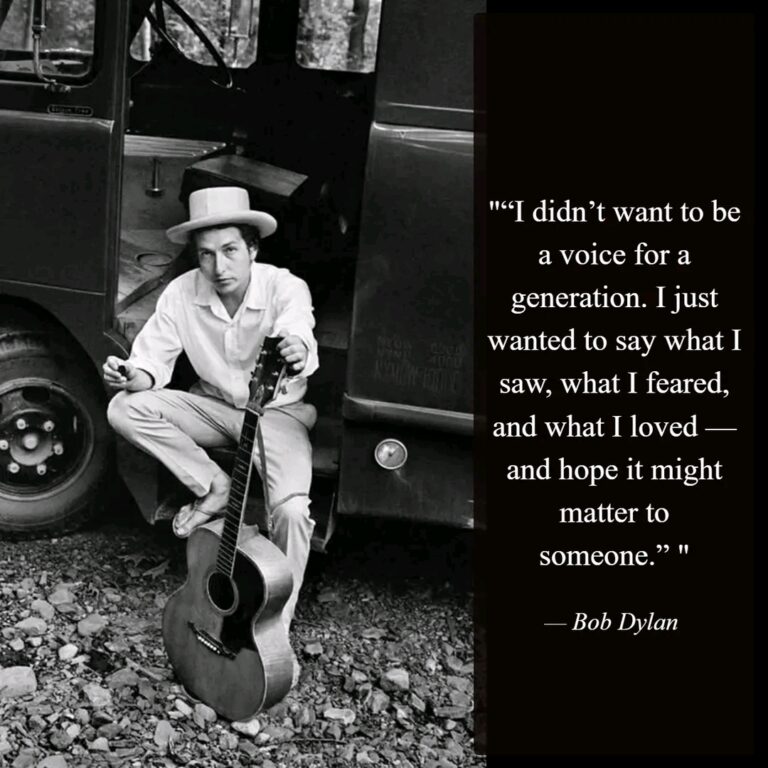Bob Dylan: The Relentless Voice of Change Still Echoes Through Generations
Bob Dylan, born Robert Zimmerman in Duluth, Minnesota, in 1941, is not merely a musician — he is a cultural force. Over six decades, Dylan has redefined the boundaries of songwriting, bending genres, subverting expectations, and giving voice to generations grappling with change, injustice, and the search for meaning. From his humble beginnings on the early 1960s folk scene to receiving the Nobel Prize in Literature in 2016, Dylan’s life and work stand as an unyielding testament to the power of words and music.
A Voice for the Times
Dylan’s rise began in the coffeehouses and clubs of New York City’s Greenwich Village. In 1962, he released his self-titled debut album, but it was the following year’s The Freewheelin’ Bob Dylan that catapulted him into the cultural spotlight. Songs like “Blowin’ in the Wind” and “A Hard Rain’s a-Gonna Fall” became anthems of the Civil Rights Movement and antiwar protests, positioning Dylan as the voice of a restless, reform-minded generation.
He would go on to solidify this reputation with the 1964 album The Times They Are A-Changin’, a stark, poetic reflection of societal transformation. With each verse, Dylan distilled the spirit of the 1960s — a decade teeming with upheaval and potential — into lyrics that challenged listeners to reflect and respond.
Breaking Folk’s Chains: The Electric Revolution
But Dylan was never one to be boxed in. In 1965, he took a monumental leap that would both ignite controversy and redefine rock music. With Highway 61 Revisited, featuring the incendiary “Like a Rolling Stone,” Dylan plugged in, leaving behind the acoustic folk purism for a raw, electric sound that fused blues, poetry, and rock ‘n’ roll. The backlash from folk traditionalists was fierce — he was booed at the Newport Folk Festival — but Dylan stood firm, and history has since sided with his evolution.
His trilogy of mid-1960s albums — Bringing It All Back Home, Highway 61 Revisited, and Blonde on Blonde — are widely considered some of the most innovative records in rock history. The lyrics were surreal, the instrumentation experimental, and the attitude unmistakably rebellious.
The Poet of Pain and Redemption
Dylan’s journey through the decades has never followed a predictable path. After a near-fatal motorcycle crash in 1966, he withdrew from the public eye and reemerged with a quieter, more introspective sound. Albums like John Wesley Harding and Nashville Skyline revealed a gentler Dylan exploring themes of Americana, religion, and redemption.
In 1975, Dylan released Blood on the Tracks, a deeply personal, emotionally raw album considered by many to be his masterpiece. Reflecting the turmoil of his own dissolving marriage, songs like “Tangled Up in Blue” and “Simple Twist of Fate” showcased his unmatched ability to fuse heartache and poetry. A year later, he released Desire, another critical success that further expanded his sound and lyrical reach.
Reinvention and Renaissance
Dylan’s career is marked by a constant reinvention — sometimes polarizing, always bold. The 1980s were a mixed bag of spiritual exploration and critical confusion. But in 1997, he stunned critics and fans alike with Time Out of Mind, a haunting meditation on aging, death, and loss. The album won a Grammy for Album of the Year and sparked a creative renaissance that has yet to fade.
Perhaps no moment in Dylan’s later years was more unexpected — or more deserved — than when he was awarded the Nobel Prize in Literature in 2016. The Swedish Academy honored him for “creating new poetic expressions within the great American song tradition,” recognizing Dylan not only as a songwriter but as a literary titan.
The Never Ending Tour and Rough and Rowdy Truths
In 1988, Dylan launched what would become known as the Never Ending Tour — a relentless series of concerts that spanned over three decades. Night after night, year after year, Dylan reworked his classic songs, kept his setlists fluid, and performed with a dedication that defied age or fatigue. This commitment to live performance became part of his legend — a troubadour forever on the road, refusing to settle or stagnate.
Even in the face of a global pandemic, Dylan’s creative fire didn’t dim. In 2020, at the age of 79, he released Rough and Rowdy Ways, a critically acclaimed album that felt both ancient and timely. With songs like “Murder Most Foul,” a 17-minute meditation on the JFK assassination and American myth, Dylan reminded the world that his pen still wielded unmatched power.
A Symbol of Creative Independence
Dylan’s mystique — his refusal to explain himself, his ability to disappear and reappear on his own terms — has only deepened his influence. He has never pandered to trends, never explained away his contradictions. In doing so, he became a symbol of creative independence, an artist who exists beyond the grasp of fame, commerce, or conformity.
As he turns 84, Bob Dylan remains one of the most enduring and enigmatic figures in music history. Whether viewed as a poet, prophet, rebel, or recluse, one truth remains: Dylan changed the way we hear music — and the way we listen to the world.
And he’s still not done.
